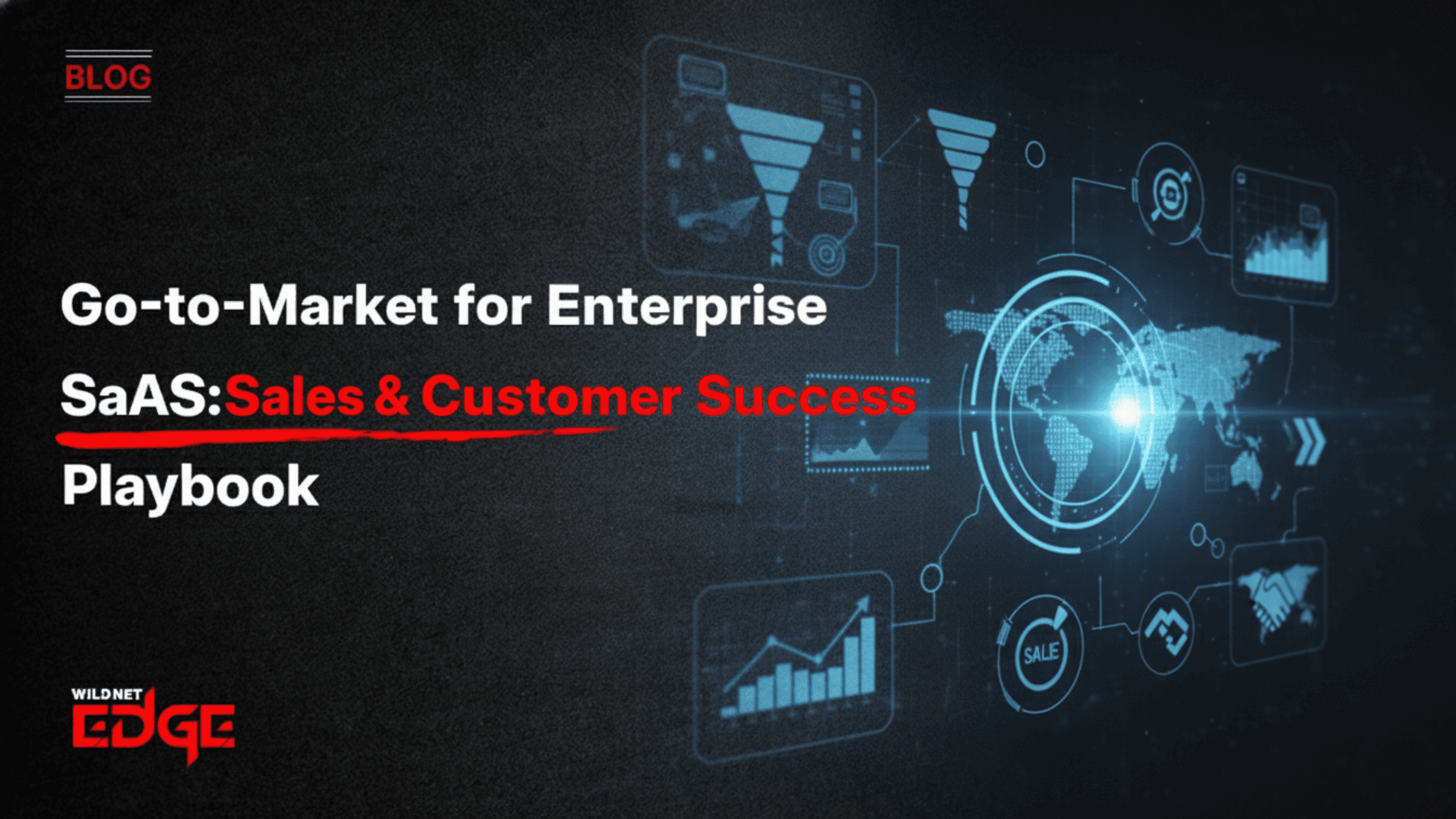TL;DR
This article provides a strategic playbook for launching and scaling enterprise Software-as-a-Service (SaaS) products. It emphasizes that a successful go-to-market SaaS plan requires a deep understanding of the complex enterprise sales cycle and a relentless focus on customer value. The guide outlines key components of an enterprise SaaS launch strategy, including defining the Ideal Customer Profile (ICP), crafting a compelling value proposition, and choosing the right pricing model. It highlights the critical roles of B2B SaaS sales enablement, equipping sales teams with the right tools and content, and customer success in SaaS, proactively ensuring clients achieve their desired outcomes post-sale. Ultimately, a coordinated approach across product, marketing, sales, and success is presented as essential for achieving sustainable growth.
Launching a Software-as-a-Service (SaaS) product into the enterprise market is a fundamentally different challenge than targeting consumers or small businesses. Enterprise clients have complex needs, longer sales cycles, multiple stakeholders, and high expectations for value and support. A successful go-to-market SaaS strategy for this segment requires meticulous planning, a deep understanding of the buyer’s journey, and a seamless integration between sales execution and long-term customer success. This playbook outlines the critical components for building and scaling your enterprise SaaS venture.
Understanding the Enterprise SaaS Landscape
Before crafting your strategy, recognize the unique characteristics of the enterprise market:
- Longer Sales Cycles: Decisions involve multiple departments (IT, finance, legal, business units) and require months of engagement.
- Higher Customer Lifetime Value: Enterprise contracts are typically larger and more lucrative, making retention paramount.
- Complex Needs: Solutions often require customization, deep integrations, and robust security/compliance features.
- Relationship-Driven: Sales rely heavily on building trust and demonstrating a deep understanding of the client’s business.
Your enterprise SaaS launch strategy must account for these realities from day one.
Phase 1: Pre-Launch Strategy & Planning
This foundational phase sets the stage for everything that follows.
Deeply Define Your Ideal Customer Profile (ICP)
Who are your exact target companies (industry, size, region)? Who are the key decision-makers, influencers, and end-users within those companies? What are their specific pain points that your solution addresses? A granular ICP informs your product roadmap, marketing messages, and sales targeting.
Craft a Compelling Value Proposition
Enterprises buy solutions, not just software. Clearly articulate the measurable business outcome your SaaS delivers. How does it save costs, increase revenue, mitigate risk, or improve efficiency? Your value proposition must resonate with executive-level priorities. This often requires strategic input, sometimes through services focused on go-to-market product planning.
Choose Your Pricing and Packaging Model
Select a model that aligns with the value delivered and how enterprises prefer to buy (e.g., tiered features, usage-based components, value-based elements). Ensure your pricing is justifiable based on the expected ROI for the client.
Develop Your Initial Sales & Marketing Plan
How will you reach your first 10 enterprise clients? This often involves targeted content marketing (white papers, case studies), account-based marketing (ABM), and direct outbound sales efforts rather than broad advertising. Effective planning requires strong SaaS GTM strategy enablement.
Phase 2: Launch & Initial Traction
Executing the launch requires coordination across teams.
Product Readiness
Ensure your SaaS platform is stable, secure, and meets the core needs defined in your MVP or initial release. Robustness is key for enterprise clients.
B2B SaaS Sales Enablement
Equipping your early sales team is critical. B2B SaaS sales enablement involves providing them with:
- Clear Messaging: Consistent value propositions and objection handling.
- Sales Collateral: Polished presentations, case studies, security documentation.
- Product Training: Deep understanding of the software and its benefits.
- CRM & Tools: Systems to manage the complex enterprise sales process effectively.
Initial Marketing Execution
Launch your planned marketing activities. Focus on generating high-quality leads that match your ICP, rather than sheer volume. Early case studies from beta clients are invaluable social proof.
Phase 3: Scaling Growth with Sales & Customer Success
Once you have initial traction, the focus shifts to scaling revenue and ensuring long-term customer value.
Optimizing the Enterprise Sales Process
Refine your sales stages, identify key conversion points, and train your sales team continuously. Implement metrics to track pipeline velocity, win rates, and customer acquisition cost (CAC). Building scalable enterprise SaaS for commerce platforms requires a particularly well-defined sales motion.
The Critical Role of Customer Success in SaaS
For enterprise SaaS, customer success in SaaS is not just post-sale support; it’s a proactive revenue driver. Customer Success Managers (CSMs) are responsible for:
- Onboarding & Adoption: Ensuring new clients are implemented smoothly and users actively leverage the platform.
- Value Realization: We actively work with clients to ensure they are achieving the business outcomes for which they purchased the software.
- Relationship Management: Building strong relationships with key stakeholders within the client organization.
- Renewals & Expansion: Identifying opportunities for upselling or cross-selling and ensuring contract renewals.
A strong Customer Success function is the key to minimizing churn and maximizing LTV in the enterprise segment. This often requires sophisticated internal tools, potentially involving custom software-to-SaaS transformation of existing processes.
Our Enterprise SaaS GTM Services in Action: Case Studies
Case Study 1: A FinTech’s Entry into Banking
- The Challenge: A FinTech startup had a groundbreaking compliance tool but struggled to navigate large banks’ long sales cycles and complex requirements. Their initial go-to-market SaaS strategy was failing.
- Our Solution: We helped them refine their ICP, develop enterprise-specific messaging focused on risk mitigation and ROI, and build targeted sales collateral (security whitepapers, compliance checklists). We also advised structuring pilot programs that are acceptable to large financial institutions.
- The Result: They successfully closed deals with three major banks within 12 months. The refined strategy and strong B2B SaaS sales enablement materials were critical in building credibility and navigating the complex procurement process.
Case Study 2: A Marketing Tech Platform Reducing Churn
- The Challenge: A marketing SaaS company had strong acquisitions but suffered from high churn among its larger enterprise clients after the first year. Users weren’t fully adopting the advanced features.
- Our Solution: We helped them implement a dedicated Customer Success team and strategy. This included developing a structured onboarding program, defining key value realization milestones, and implementing proactive health checks for key accounts. Improving customer success in SaaS became their top priority.
- The Result: The enterprise churn rate decreased by 30% within 18 months. Due to the proactive support from CSMs, clients reported higher satisfaction and were significantly more likely to expand their usage and renew their contracts.
Our Technology Stack & Expertise
We leverage tools and expertise across the GTM spectrum.
- CRM: Salesforce, HubSpot
- Sales Enablement: Seismic, Highspot, Outreach.io
- Customer Success: Gainsight, ChurnZero, Catalyst
- Marketing Automation: Marketo, Pardot, HubSpot
- Analytics: Tableau, Power BI, Mixpanel
Conclusion
A successful go-to-market SaaS strategy for the enterprise segment is a complex, ongoing process that requires deep alignment between product, marketing, sales, and customer success. By focusing on solving high-value problems, effectively enabling your sales team through B2B SaaS sales enablement, and investing heavily in proactive customer success in SaaS, you can build a sustainable, high-growth business.
Ready to build and scale your enterprise SaaS venture? At Wildnet Edge, our AI-first approach enhances every stage, from predictive lead scoring to intelligent customer health monitoring. We provide end-to-end support, including product lifecycle scaling services, to turn your vision into market leadership.
FAQs
Enterprise sales cycles commonly range from 6 to 18 months, depending on the deal size, product complexity, and the number of stakeholders involved in the decision-making process.
Customer Support is typically reactive, solving problems as they arise. Customer Success in SaaS is proactive; its goal is to ensure customers achieve their desired business outcomes using your product, maximize value, and provide renewal and expansion.
Key metrics include Customer Acquisition Cost (CAC), Customer Lifetime Value (LTV), Churn Rate (logo and revenue), Net Revenue Retention (NRR), Sales Cycle Length, and Pipeline Velocity.
For most startups and scale-ups, buying established sales enablement platforms (like Seismic or Highspot for content management, Outreach/Salesloft for engagement) is far more efficient than building these complex tools in-house. Focus your development resources on your core product.
You should typically hire your first CSM before you feel you desperately need one, often around the time you onboard your first handful of significant enterprise clients. Their role is crucial from the beginning to ensure successful implementation and long-term value realization.
While often associated with SMBs, PLG elements (like free trials or freemium versions focused on specific features) can be part of an enterprise SaaS launch strategy. They can help generate initial user interest and identify potential champions within a large organization, complementing a direct sales motion.
Enterprise buyers are focused on ROI, security, compliance, and integration. Your content (white papers, case studies, webinars) should address these specific concerns, demonstrate a deep understanding of their industry, and provide clear evidence of business value rather than just focusing on product features.

Nitin Agarwal is a veteran in custom software development. He is fascinated by how software can turn ideas into real-world solutions. With extensive experience designing scalable and efficient systems, he focuses on creating software that delivers tangible results. Nitin enjoys exploring emerging technologies, taking on challenging projects, and mentoring teams to bring ideas to life. He believes that good software is not just about code; it’s about understanding problems and creating value for users. For him, great software combines thoughtful design, clever engineering, and a clear understanding of the problems it’s meant to solve.
 sales@wildnetedge.com
sales@wildnetedge.com +1 (212) 901 8616
+1 (212) 901 8616 +1 (437) 225-7733
+1 (437) 225-7733































